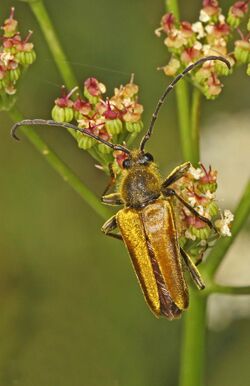Biology:Lepturobosca chrysocoma
| Lepturobosca chrysocoma | |
|---|---|

| |
| Scientific classification | |
| Domain: | Eukaryota |
| Kingdom: | Animalia |
| Phylum: | Arthropoda |
| Class: | Insecta |
| Order: | Coleoptera |
| Infraorder: | Cucujiformia |
| Family: | Cerambycidae |
| Genus: | Lepturobosca |
| Species: | L. chrysocoma
|
| Binomial name | |
| Lepturobosca chrysocoma Kirby
| |
| Synonyms | |
| |
Lepturobosca chrysocoma is a species of beetle in the family Cerambycidae. It was described as Cosmosalia chrysocoma by William Kirby in 1837.[1] In 1998, comparison of Cosmalia chrysocoma with Lepturobosca virens by the Russian entomologist Alexander Ivanovich Miroshnikov resulted in Cosmalia and Lepturobosca grouped together under the name Lepturobosca.[2][3] Common names used for this beetle include Yellow velvet beetle,[4] Golden flower longhorn beetle[5] and Golden-haired flower longhorn.[6]
This beetle is known to occur in Canada in British Columbia, Alberta, Saskatchewan, Manitoba, Ontario, Quebec, New Brunswick, Nova Scotia, Newfoundland, Prince Edward Island, Northwest Territories and the Yukon Territory. It has been found in the United States in Montana and Wyoming.[5]
The beetles are 10–20 millimetres (0.39–0.79 in) long[7] and are covered by a dense coat of golden hairs.[2][7][6] Adult beetles are frequently seen feeding on flowers in the summer.[2] Their hairy coats pick up pollen, which is transferred to other flowers as they feed, allowing pollination.[2][6]
Larvae feed on decaying wood of trees,[6] including Picea mariana and Populus.[8][9]
This species is a known host for Coleocentrus quebecensis, a parasitic wasp in the subfamily Acaenitinae.[8]
References
- ↑ Bezark, Larry G. A Photographic Catalog of the Cerambycidae of the World. Retrieved 22 May 2012..
- ↑ 2.0 2.1 2.2 2.3 Schapker, M.S., Phil (April 2017). "The Lepturine Longhorn Beetles (Cerambycidae: Lepturinae) of the Pacific Northwest and Other Stories" (pdf). p. 43. https://www.cerambycoidea.com/titles/schapker2017.pdf. "North Americans since Casey (1913) had thought that no species directly related to Cosmosalia existed outside the continent. However, the uncanny resemblance of the North American species to the Palearctic Lepturobosca virens Linnaeus was pointed out by the Russian taxonomist A. Miroshnikov. Miroshnikov (1998) provided illustrations of the male genitalia of all three species as additional evidence for the group’s relatedness, and grouped them into one genus, Lepturobosca, with Cosmosalia as a subgenus. (The original description of Lepturobosca Reitter, 1913, was published slightly earlier in the year, and has priority over Cosmosalia Casey, 1913; see Miroshnikov, 1998.)"
- ↑ Miroshnikov, A.I. (1998). "Reclassification of longhorn beetles of the Anoplodera complex, tribe Lepturini (Coleoptera, Cerambycidae) of the Holarctic fauna: I.". Entomological Review 78 (4): 437-465.
- ↑ "Yellow Velvet Beetle (Lepturobosca chrysocoma)" (in en). https://www.inaturalist.org/taxa/332243-Lepturobosca-chrysocoma.
- ↑ 5.0 5.1 "Lepturobosca chrysocoma Golden Flower Longhorn Beetle". NatureServe. https://explorer.natureserve.org/Taxon/ELEMENT_GLOBAL.2.919179/Lepturobosca_chrysocoma.
- ↑ 6.0 6.1 6.2 6.3 Cressman, Anna. "Golden-haired flower longhorn (Lepturobosca chrysocoma)". UW-NPS Research Station. https://uwnps.org/golden-haired-flower-longhorn-lepturobosca-chrysocoma/.
- ↑ 7.0 7.1 "Species Lepturobosca chrysocoma". https://bugguide.net/node/view/19893.
- ↑ 8.0 8.1 Gardiner, L. M. (1970). "Biological Notes on some Nearctic Lepturinae (Coleoptera: Cerambycidae)". The Pan-Pacific Entomologist (San Francisco) 46 (4): 284-288.
- ↑ Linsley, E. G.; Chemsak, J. A. (1972). "Cerambycidae of North America. Part VI. No. 1. Taxonomy and Classification of the Subfamily Lepturinae". University of California Publications in Entomology 69.
Wikidata ☰ Q106519311 entry
 |

